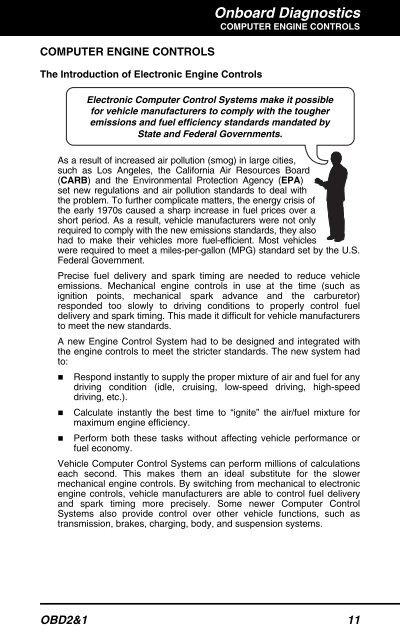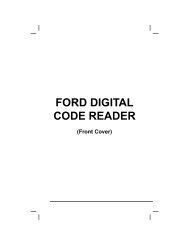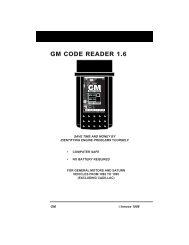Create successful ePaper yourself
Turn your PDF publications into a flip-book with our unique Google optimized e-Paper software.
COMPUTER ENGINE CONTROLS<br />
The Introduction of Electronic Engine Controls<br />
Onboard Diagnostics<br />
COMPUTER ENGINE CONTROLS<br />
Electronic Computer Control Systems make it possible<br />
for vehicle manufacturers to comply with the tougher<br />
emissions and fuel efficiency standards mandated by<br />
State and Federal Governments.<br />
As a result of increased air pollution (smog) in large cities,<br />
such as Los Angeles, the California Air Resources Board<br />
(CARB) and the Environmental Protection Agency (EPA)<br />
set new regulations and air pollution standards to deal with<br />
the problem. To further complicate matters, the energy crisis of<br />
the early 1970s caused a sharp increase in fuel prices over a<br />
short period. As a result, vehicle manufacturers were not only<br />
required to comply with the new emissions standards, they also<br />
had to make their vehicles more fuel-efficient. Most vehicles<br />
were required to meet a miles-per-gallon (MPG) standard set by the U.S.<br />
Federal Government.<br />
Precise fuel delivery and spark timing are needed to reduce vehicle<br />
emissions. Mechanical engine controls in use at the time (such as<br />
ignition points, mechanical spark advance and the carburetor)<br />
responded too slowly to driving conditions to properly control fuel<br />
delivery and spark timing. This made it difficult for vehicle manufacturers<br />
to meet the new standards.<br />
A new Engine Control System had to be designed and integrated with<br />
the engine controls to meet the stricter standards. The new system had<br />
to:<br />
� Respond instantly to supply the proper mixture of air and fuel for any<br />
driving condition (idle, cruising, low-speed driving, high-speed<br />
driving, etc.).<br />
� Calculate instantly the best time to “ignite” the air/fuel mixture for<br />
maximum engine efficiency.<br />
� Perform both these tasks without affecting vehicle performance or<br />
fuel economy.<br />
Vehicle Computer Control Systems can perform millions of calculations<br />
each second. This makes them an ideal substitute for the slower<br />
mechanical engine controls. By switching from mechanical to electronic<br />
engine controls, vehicle manufacturers are able to control fuel delivery<br />
and spark timing more precisely. Some newer Computer Control<br />
Systems also provide control over other vehicle functions, such as<br />
transmission, brakes, charging, body, and suspension systems.<br />
OBD2&1 11




